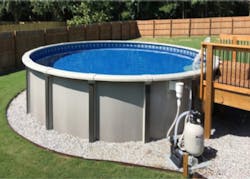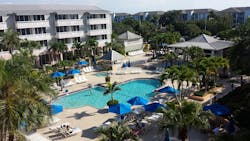As an electrical contractor, electrician, or installer, before you start a job, it is always critical to know which set of National Electrical Code (NEC) rules are going to be applied to your specific installation. The same can be said for your local electrical inspector. Which set of NEC rules am I obligated to enforce on this particular job site?
Until changes that occurred in the 2023 edition of the NEC, this was not an easy, cut-and-dry answer when it came to a permanently installed swimming pool versus a storable pool. For years, what mainly distinguished a storable pool from a permanently-installed pool was its water depth. In past Code cycles (including the 2020 NEC), a storable pool (Photo 1) was defined as a pool intended to be stored when not in use that was constructed on or above the ground and capable of holding water to only a depth of 42 in. On the other hand, a permanently installed swimming pool (Photo 2) has historically been defined as a pool constructed in the ground or partially in the ground or any other pool capable of holding water at a depth greater than 42 in.
As clearly indicated in these definitions, there seems to be a dividing line and something magic about this 42-in. depth of water when it comes to a storable pool versus a permanently installed pool. With that in mind, let’s take a look at the origin of this seemingly magic number.
A look back
Prior to the 1975 edition of the NEC, the definition of a storable or permanently installed pool did not contain a prescriptive wall height or water depth. For the 1978 NEC, a proposed wall height of 3 ft was added to the definition of a storable pool. This change was submitted by the NEC Code-Making Panel (CMP-20), which had purview over Art. 680 [Swimming Pools, Fountains, and Similar Installations] at that time. In their Committee Statement for justifying this maximum wall height of 3 ft, CMP-20 indicated that the availability of increasingly larger sizes of above-ground pools made it necessary to clarify the intent of the definition by including maximum dimensions.
During the 1981 NEC revision cycle, a proposal was accepted to revise the definition of a storable pool by increasing the maximum 3-ft wall height limitation for a storable pool to a pool capable of holding water to a maximum depth of 42 in. This proposal was submitted on behalf of the National Swimming Pool Institute seeking to change the definition of a storable pool to “a removable pool of any shape whose frame is located entirely above ground; these pools may be readily disassembled for storage and reassembled to their original integrity.” Notice that no depth dimension was proposed. In the substantiation for this proposed revised definition, the submitter stated that the current 1978 NEC definition of storable pool “inaccurately and inadequately describes the current products on the marketplace today.” The submitter went on to say that approximately 85% of the above-ground pools sold in 1981 were greater than 3 ft in depth (typically 42 in. to 48 in.), came in a variety of shapes , and may have had a maximum dimension of greater than 15 ft.
To be clear, the submitter’s intent (for the 1981 NEC) was to remove the prescriptive maximum wall height of
3 ft for a storable pool. To the contrary, the technical committee took action to increase the maximum height of a storable pool from 3 ft to 42 in. This was done without a whole lot of substantiation as to why the maximum height of 42 in. (and not 48 in. or some other dimension) was chosen. There is some indication that the 42-in. maximum water depth was tied to a storable pool wall height of 45 in. This 42-in. maximum water depth has lived on in the definition of a storable pool from the 1981 NEC until the 2020 edition of the NEC.
What it means today
What does all of this have to do with you, the electrical contractor? Manufacturers have been producing storable pools with wall heights of 48 in. for over 40 years without any negative impact on electrical safety. Today, it is very common to see storable pools that exceed the defined 42-in. water depth, but qualify in every other way as a storable pool. From an electrical safety standpoint, these storable pools capable of holding water at a depth greater than 42 in. (not meeting the previous definition of a storable pool) are no different than pools that has a maximum 42-in. water depth (meeting the previous definition of a storable pool). Providing requirements for electrical safety around a storable pool is not impacted if the maximum water depth is greater than 42 in. However, while enforcing the 2020 NEC, the Authority Having Jurisdiction (AHJ) has no choice but to treat this seemly storable pool as a permanently installed pool if the maximum water depth is greater than 42 in.
A “storable pool” is typically set up on level ground and comes in a complete package that can typically be set up in an hour or so without many tools when the instruction manual identifies it as a storable pool. If this storable pool is also capable of holding water at a depth greater than 42 in. (which many can), under 2020 Code language (and previous editions) and definitions of storable and permanently installed pools, this storable pool would have to comply with Part II of Art. 680 for a permanently installed pool. For one thing, this would mean having to establish an equipotential bonding grid per NEC Sec. 680.26 for what appears to be a storable pool.
Once this defined 42-in. limitation is broken, the AHJ knows that Part II of Art. 680 must somehow be applied. The difficulty comes as the equipotential bonding grid cannot be bonded to this “storable pool” at four points [Sec. 680.26(B)(2)], the pool water cannot be bonded to the equipotential bonding grid [Sec. 680.26(C)], the pool pump for this “storable pool” is double insulated and cannot be bonded [Sec. 680.26(B)(6) and Exception], and a solid 8 AWG copper equipotential bonding conductor cannot be connected to the equipment grounding conductor of the branch circuit supplying the pump motor [Sec. 680.26(B)(6)(a)] — just to name a few.
For the 2023 edition of the NEC, the definitions for a storable pool and a permanently installed pool have been revised to address these issues we discussed to this point. The definition of a “storable pool” now indicates that a storable pool would be installed entirely on or above the ground and intended to be stored when not in use and would be designed for ease of relocation, regardless of the water depth. This revised definition is uncannily similar to the originally proposed definition of a storable pool in the 1981 NEC that was not accepted.
Also, for the 2023 NEC, a “permanently installed pool” is now defined as a pool that is constructed or installed in the ground or partially in the ground and all pools installed inside of a building. The 2023 NEC revised definition goes on to state that these pools would qualify as a permanently-installed pools, whether they are served by electrical circuits of any nature or not.
Notice that both of these revised definitions are void of any qualifying depth of the pool or water level. The technical committee (CMP-17) indicated in their Panel Statement that these definitions were being revised to affirm that any electrical hazards associated with a storable or permanently installed pool are not related to the depth of the said pool. The submitter of the Public Inputs to bring about these revised definitions indicated that these changes were necessary to address multiple adverse impacts created with a prescriptive limitation of a 42-in. water depth. Newer designs in storable pools allow for depths greater than 42 in., and the addition of a few inches of water has no impact on electrical safety. These revised definitions for the 2023 NEC will bring much-needed relief to both the installer and the inspector when it comes to applying the proper parts of Art. 680 and NEC rules to bodies of water — be they storable or permanently installed. NEC definitions are always important in any electrical installation. These revised definitions will make it much easier to comply with or enforce safe and proper electrical rules for both of these different aquatic applications.
L. Keith Lofland (retired) is the former director of education for IAEI. He can be reached at [email protected].Inspector Intel articles are provided by the International Association of Electrical Inspectors (IAEI), www.iaei.org, a membership-driven, non-profit association headquartered in Richardson, Texas, that promotes electrical safety throughout the industry by providing education, certification of inspectors, advocacy, partnerships, and expert leadership in electrical codes and standards.
About the Author
L. Keith Lofland
Director of Education, Codes and Standards
L. Keith Lofland (retired) is the former director of education for IAEI. Keith represented IAEI as Chairman of NFPA’s Code Making Panel (CMP) 7 for the National Electrical Code (NEC) for the 2020 and the 2023 NEC. Previously, he served 3 Code cycles as a member of CMP-9. In his career, Keith served on NFPA’s Electrical Section Executive Committee and as a member of UL’s Electrical Council. He was the principal author for six Code cycles of several IAEI publications including IAEI’s NEC Analysis of Changes. Prior to his position with the International Office of IAEI, Keith spent 16 years with the City of Garland (Texas) serving as its chief electrical inspector. Keith holds a Master Electrician license from the State of Texas. He also has obtained Electrical Inspector certifications from IAEI and ICC. Keith received the “Building Official/Building Inspector of the Year” award in 1999 from the Construction Research Center-University of Texas at Arlington. Keith received the Gold Roadrunner award in 2014 for development and promotion of the NEC as a presenter and educator.


